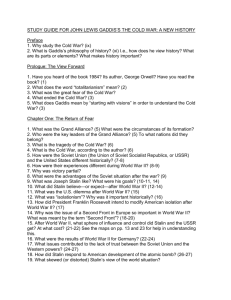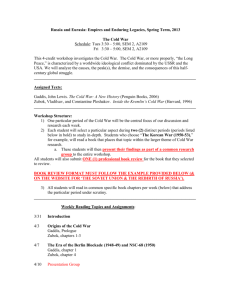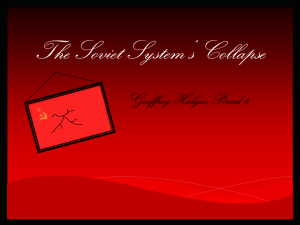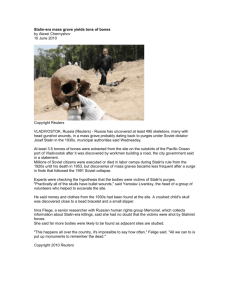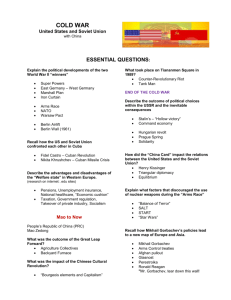Name Hour 1 2 3 4 5 6 Date The Cold War: A New History John
advertisement
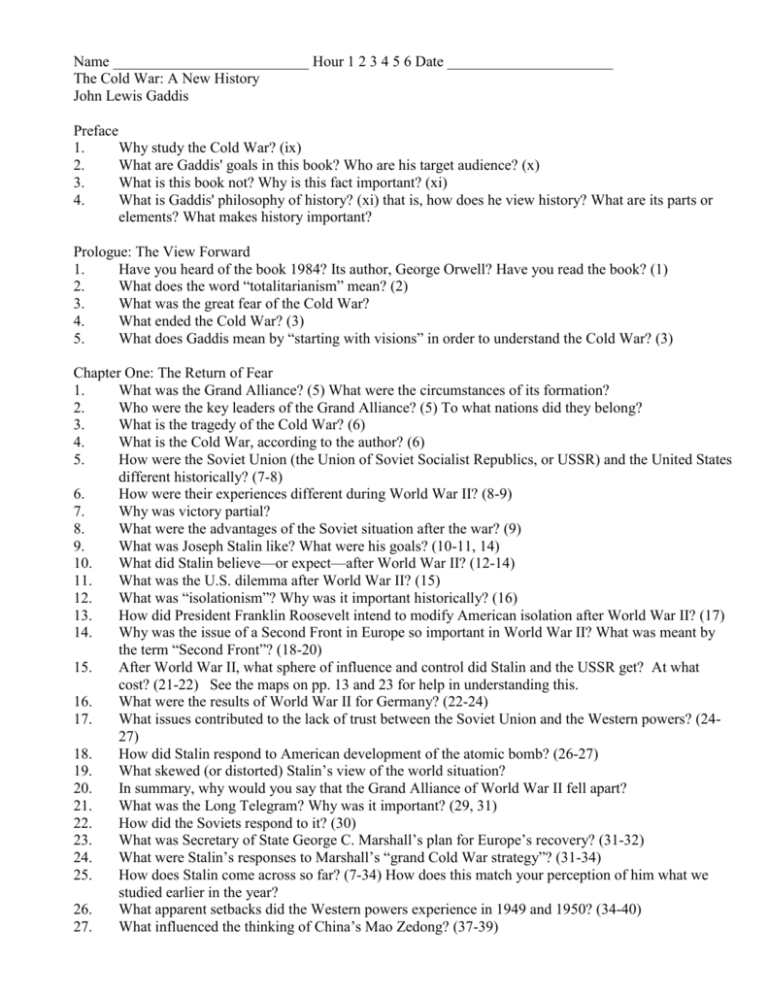
Name __________________________ Hour 1 2 3 4 5 6 Date ______________________ The Cold War: A New History John Lewis Gaddis Preface 1. Why study the Cold War? (ix) 2. What are Gaddis' goals in this book? Who are his target audience? (x) 3. What is this book not? Why is this fact important? (xi) 4. What is Gaddis' philosophy of history? (xi) that is, how does he view history? What are its parts or elements? What makes history important? Prologue: The View Forward 1. Have you heard of the book 1984? Its author, George Orwell? Have you read the book? (1) 2. What does the word “totalitarianism” mean? (2) 3. What was the great fear of the Cold War? 4. What ended the Cold War? (3) 5. What does Gaddis mean by “starting with visions” in order to understand the Cold War? (3) Chapter One: The Return of Fear 1. What was the Grand Alliance? (5) What were the circumstances of its formation? 2. Who were the key leaders of the Grand Alliance? (5) To what nations did they belong? 3. What is the tragedy of the Cold War? (6) 4. What is the Cold War, according to the author? (6) 5. How were the Soviet Union (the Union of Soviet Socialist Republics, or USSR) and the United States different historically? (7-8) 6. How were their experiences different during World War II? (8-9) 7. Why was victory partial? 8. What were the advantages of the Soviet situation after the war? (9) 9. What was Joseph Stalin like? What were his goals? (10-11, 14) 10. What did Stalin believe—or expect—after World War II? (12-14) 11. What was the U.S. dilemma after World War II? (15) 12. What was “isolationism”? Why was it important historically? (16) 13. How did President Franklin Roosevelt intend to modify American isolation after World War II? (17) 14. Why was the issue of a Second Front in Europe so important in World War II? What was meant by the term “Second Front”? (18-20) 15. After World War II, what sphere of influence and control did Stalin and the USSR get? At what cost? (21-22) See the maps on pp. 13 and 23 for help in understanding this. 16. What were the results of World War II for Germany? (22-24) 17. What issues contributed to the lack of trust between the Soviet Union and the Western powers? (2427) 18. How did Stalin respond to American development of the atomic bomb? (26-27) 19. What skewed (or distorted) Stalin’s view of the world situation? 20. In summary, why would you say that the Grand Alliance of World War II fell apart? 21. What was the Long Telegram? Why was it important? (29, 31) 22. How did the Soviets respond to it? (30) 23. What was Secretary of State George C. Marshall’s plan for Europe’s recovery? (31-32) 24. What were Stalin’s responses to Marshall’s “grand Cold War strategy”? (31-34) 25. How does Stalin come across so far? (7-34) How does this match your perception of him what we studied earlier in the year? 26. What apparent setbacks did the Western powers experience in 1949 and 1950? (34-40) 27. What influenced the thinking of China’s Mao Zedong? (37-39) 28. 29. 30. 31. 32. How did Cold War realities spread to Korea? Southeast Asia? (40-42) Discuss the Korean War, using the map on p. 44. How did Mao’s response to the Korean War differ from Stalin’s? (43-45) Summary: How would you describe the world situation as of 1950? (46-47) What, according to Gaddis, does this say about human nature? (47) Do you agree? Chapter Two: Deathboats and Lifeboats 1. 2. 3. 4. 5. 6. 7. 8. 9. 10. 11. 12. 13. 14. 15. 16. 17. 18. 19. 20. What was your response to Gaddis' story on pp. 48 and 49? Why do you think he inserted that two-paragraph story? Why didn’t it happen that way? What is meant by a “limited” war? Why was that a reality during the Cold War? (50-52 and ff.) Has human nature changed regarding warfare, as the author maintains at the bottom of p. 52? What has changed? (52-53) Aside from the destructive capacity of nuclear weapons, what were the problems with their use in warfare? (54, 59) What do you think of President Harry Truman’s attitudes and policy toward nuclear weapons? What do you think of his leadership at this critical time? (50-55) How did Joseph Stalin react to the U.S. monopoly of atomic weapons? (56-58) Was he being realistic? What is your impression of Joseph Stalin to this point in the book? Again, has your perception of him changed from earlier studies? What were the arguments for building a hydrogen bomb? (61-62) Do the arguments make sense? How did President Dwight D. Eisenhower differ from Truman? (64,66) Why? What dilemmas did Eisenhower and his administration face? (66-67) How did they resolve the dilemmas? (68) What was Nikita Khrushchev like? Describe his character, attitudes, and behavior. (68-72, 78-79) What is a Potemkin village? (72) If you don’t know, look it up! Why were U-2 spy-plane flights and satellite photographs critical for the Americans in the late 1950s? (72-75) Why did Khrushchev provoke the Cuban Missile Crisis in October of 1962? (75-77) How did he behave during the crisis? (77-78) How was the Cuban Missile Crisis resolved? (78-79) Under Secretary of Defense Robert McNamara’s guidance, what strategic doctrine and understandings emerged from the missile crisis? Explain MAD. (80-81) What were these treaties and understandings based on? (81-82) How did nuclear weapons ironically contribute to the survival of both sides in the Cold War? Is nuclear war “irrational,” as Gaddis contends? Is “war . . . no longer . . . an instrument of statecraft”? (81) Chapter Three: “Command versus Spontaneity” This chapter is heavy on ideology and light on historical background. Don’t forget your notes on ideology from earlier in the year. 1. 2. 3. 4. How did communist ideology influence people during the earlier part of the Cold War? What accounted for its strength as an ideology? (84-85) What do the words “bourgeois,” “bourgeoisie,” “proletarian,” and “coup d'état” mean? The Cold War was prominently a contest of ideas. What was the big issue that was implicitly debated during the Cold War? How did the communists, following Karl Marx and Vladimir Lenin, understand the world and the future? (84-89) Gaddis uses President Woodrow Wilson as a contrast to communist thinkers. What kind of world did Wilson desire after World War I? (87, 91-93) 5. 6. 7. 8. 9. 10. 11. 12. 13. How did communists like Joseph Stalin operate in practice? (98-100) In contrast to Stalin’s methods, how did the United States and its allies plan to restore western Germany and Japan after World War II? Why? What did American leaders believe in? (101-104) How did Lavrentii Beria attempt to reverse the worst effects of Stalin’s rule? Was he successful? (104-106) How did Nikita Khrushchev, Beria’s successor, continue Beria’s move away from Stalinism? (107) What did Khrushchev want? (107) Was he successful? Why not? (108-109) How did Mao Zedong imitate Stalin? What were the results? (109-112) Why was Berlin such a big problem for the communists? What was Khrushchev’s solution? Did he have a choice? (112-115) What do you see as the deficiencies of communist ideology? Why did communism fail? What advantages did the West have over the communist East? (115-118) Chapter Four: “The Emergence of Autonomy” Why was Khrushchev’s “retirement” so different? What did it signify? (119-120) What is the author’s point when he says at the bottom of page 120 that “mallets were . . . beginning to turn into flamingos, and balls into hedgehogs”? 3. The idea and practice of holding colonies outside of Europe (colonialism) began to collapse after World War II: what replaced it? what was the result for the Cold War? (121-124) 4. What is “non-alignment”? Why was it important? (124-126) a. How does Egypt’s experience demonstrate this? (127-128) b. What does the behavior of the Korean and Chinese demonstrate? (129-133) 5. How did the United States get drawn into the Vietnam War? (133-134) 6. How did the Germans behave during the Cold War? (135-138) 7. What did French President Charles de Gaulle accomplish? (139) a. How did he behave? (139-140) Why? 8. How did China’s Mao Zedong behave toward the Soviets? What happened as a result? (141-143) 9. How did Mao and de Gaulle demonstrate chutzpah? (138-143) 10. What events characterized 1968? (144-146) 11. How did U. S. President Richard M. Nixon explain those events? How does Gaddis explain them? (145-147) 12. What was the Cultural Revolution? How did Mao respond to it? (147-148) 13. How did American and European student radicals respond to Mao? Why do you think they did that? Was he worth of their response? (147-148) NOTE the so-called Brezhnev Doctrine on page 150. 14. What did Nixon mean when he remarked to Mao: “History has brought us together . .. .”? (150-152) 15. What were the motivations to seek detente (or Ostpolitik)? What did Nixon want out of it? (153-154) 16. What did he gain out of it? What brought President Nixon down? (155) 1. 2. Chapter Five: “The Recovery of Equity” 1. What was the Watergate Scandal? (156-157) What was its result? 2. What principle played a part in President Richard Nixon’s fall? Why? (157-158) 3. What is the attraction of establishing the United Nations “upon some externally devised standard of justice”? (158) 4. Can one establish peace among nations on such a basis? Why or why not? 5. What strains on American morality did the Cold War place on the United States and its officials? (161-164) 6. 7. 8. 9. 10. 11. How, however, did the Truman and Eisenhower administrations and the Central Intelligence Agency (CIA) behave in fact? (164-165) What is a Machiavellian? (165; cf. 156) How does a Machiavellian behave? (162-167) How does one “reconcile Machiavellian practices with the constitutionally based principle of accountability”? (166) Is there a “constitutionally based principle of accountability”? Does one owe one’s enemies the same treatment one owes one’s friends, family, and fellow citizens? How are outright lies sometimes a sign of weakness and a recipe for failure? (168-169) How and why was President Lyndon Johnson willing to “sacrifice the public trust”? (169) Do Americans tolerate “plausible deniability” exercised by their leaders? Under what circumstances? Explain the Tet Offensive of January 1968 as the turning point of the Vietnam War (170). 12. 13. 14. 15. 16. 17. 18. 19. 20. 21. 22. 23. 24. Why was the Vietnam War so unsettling to the American people and the American system of government? (170-171) How did President Nixon use secrecy successfully? (171-172) How did Nixon nonetheless blur the lines between “defensible and indefensible secrecy”? (172-175) Truman’s and Eisenhower’s secret actions How does Gaddis present Nixon’s person and character? (172-175) What resulted from Watergate and Nixon’s resignation on August 9, 1974? (175-179) How did Congress in particular react? (176-177) What did Congress conclude regarding the CIA? What is detente? (180-181) How was it an alternative to Mutually Assured Destruction? (181-182) What were its advantages and disadvantages? (182-184) By 1968, what was going on in the U.S.S.R. and its allies? (185-188) E.g., how did many respond to the 1968 suppression of “Prague Spring” in Czechoslovakia? How did Premier Leonid Brezhnev want to use detente? (187-189) What were the unintended consequences of the Helsinki Accords (agreements) within the Soviet sphere of influence? (190-194) Who were the most prominent figures? What happened in Poland? According to Gaddis , what principle reasserted itself within the Soviet sphere? Why might that be important? To what developments is Gaddis referring when he says that they were “totally beyond the imagination of the Soviet leadership”? (194) Regarding the photo montage between pp. 174 and 175: a. What is the time frame of all of these pictures? b. Which pictures are particularly striking or memorable? c. Which do you not understand the importance of? d. Which people do you recognize? not recognize? e. What questions do you have about these pictures individually or as a montage? Chapter 6: “Actors” Reference Outline: Harry S. Truman was president from 1945 to 1953. Dwight D. Eisenhower, 1953-1961. John F. Kennedy, 1961-1963. Lyndon B. Johnson, 1963-1969. Richard M. Nixon, 1969-1974. Gerald Ford, 1974-1977. James E. Carter, 1977-1981. Ronald W. Reagan, 1981-1989. George H.W. Bush, 1989-1993. William J. Clinton, 1993-2001. George W. Bush, 20011. 2. 3. 4. 5. 6. 7. 8. 9. 10. 11. 12. 13. 14. 15. 16. 17. 18. 19. 20. 21. 22. 23. 24. 25. 26. 27. 28. 29. 30. 31. 32. 33. 34. Why are individual historical ‘actors’ important, according to Gaddis? (195) Who were each and why were they important? (196-197) What is detente? (198) What were its strengths and weaknesses? (198-200) What was S.A.L.T. and why was it important for detente? (200f.) What undermined detente and the SALT agreements by 1979? (202-203) How did events in the Mideast undermine detente? (204-205) How did the USSR behave in the Third World, especially Africa, in the 1970s? (206-208) What happened in Afghanistan between 1979 and 1981? (208-211) How did the world balance of power appear by the late 1970s? (212) What was the reality, especially for the USSR and its allies? (213-214) What generalizations or broad observations can you make about the Cold War, as it appeared by the 1970s? How did Deng Xiaoping change China? (214-216) What did Prime Minister Margaret Thatcher accomplish in Britain? (216-217) What was she like as a person? What did Ronald Reagan believe? What was he like? (217-218) What did Lech Walesa accomplish? (218) What is Gaddis' view of human actors in history? (195, 218, 222) What do the ‘actors’ mentioned between pages 215 and 222 have in common? What was happening within the USSR by the early 1980s? (219-222) What was President Ronald Reagan’s attitude toward Communist regimes? toward the West? (222224) What did Reagan believe in? (224-225) What did Reagan do as part of his political offensive against the Soviet Union? (225-227) Why did he repudiate MAD doctrine? (226) How did the Soviet leaders react to Reagan and his speeches? (227-228) Why? How was the new Soviet premier, Mikhail Gorbachev, different from all other Soviet leaders? (229230) What did Gorbachev decide to do in response to Reagan’s entreaties? What policies did he decide on? (231) What was Gorbachev like as a person? (229-234) What was Reagan like as a person? (222-232) What did Reagan and Gorbachev accomplish? (232-233) What did Reagan (and his secretary of state, George Schultz) persuade Gorbachev of? (232-234) How did Soviet foreign policy begin to change? (235-236) What was happening to the Soviet economy? Who was more right in the contest of global ideas? What, in general, does Gaddis think of all these actors? Chapter 7: “The Triumph of Hope” 1. Why were the French Revolution of 1789 and the “revolutions of 1989” so important? (237-238) 2. Why did the revolutions of 1989 in Eastern Europe occur? (238-239) a. How did those changes occur in Hungary? (240-241) b. What happened in Poland? (241-242) c. What was happening at the same time in the USSR? (242) 3. 4. 5. 6. 7. 8. 9. 10. 11. d. What happened in China? (242-243) e. How did events in China contrast with those in Hungary, Poland and the USSR? (242-244) f. What happened as a result in East Germany? (244-246) g. What happened in Romania? (247) How did Gorbachev respond to all these changes? (245-248) Why is this so strange? (247-248) From what you know from the book so far, why do you think that President George H.W. Bush (Bush I) was caught off guard by changes in Eastern Europe? (248-249) How was he conditioned to think? How was Gorbachev’s attitude toward the United States different than that of every other Soviet leader heretofore? (249) Who benefitted from the German reunification of October 1990? (250-252) How was Gorbachev received within the USSR? (252) What do you think he was trying to accomplish? (252-255) Why did his efforts backfire? What resulted? Why? (253-256) Who was Boris Yeltsin? Why was he important? (254-257) What did he accomplish? What did Gorbachev ultimately accomplish? How do you evaluate his leadership, especially in contrast with the other leaders listed on page 257? STUDY the map of post Cold War Europe on page 258. That is YOUR world! 12. Why is the chapter entitled “The Triumph of Hope”? Epilogue: “The View Back 1. Who does Gaddis say brought about the end of the Cold War? (259) How? 2. How does this conclusion square with his argument in Chapter Six, “Actors”? What roles do ordinary people play in world-changing historical processes? 3. Do you agree that “people who live through great events are rarely the best judges of their lasting significance”? (260) Why or why not? 4. How did the Cold War differ from previous confrontations between Great Powers? What accounts for the difference? (261-262) 5. Is war now “an anachronism”? (262) Why might Gaddis think so? 6. What ultimately defeated Communism? (263-264) 7. How has the world changed as a result of the Cold War? (262-265) 8. Does “democracy confer[] legitimacy” on governments, as your Gaddis assumes? (265) 9. 9. Remind the students of the three traditional interpretations of the Cold War: New In Summary : 1. How has Gaddis presented and interpreted the Cold War? 2. How would you describe his writing style? 3. What are the strengths of this book? 4. What is the overall value of this book? Why?
